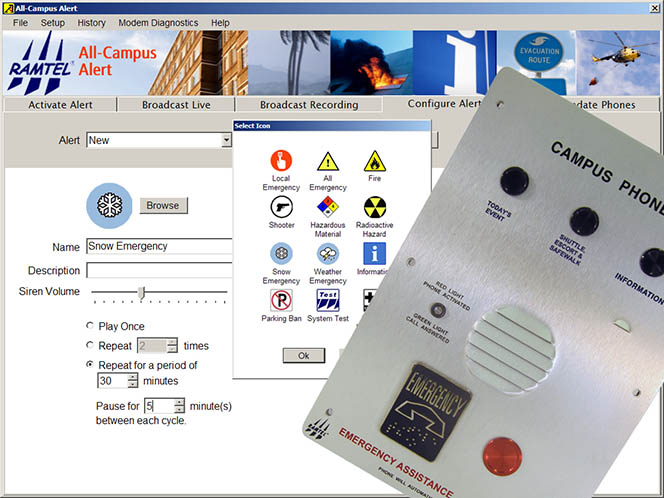BCA designed and developed microprocessor-based, phone-line powered hardware, along with the emergency alert software, currently used in security phones on over 30% of college campuses.
Context
The client company produces emergency phones used on college campuses and in communities throughout the United States. BCA’s long relationship with this client has involved expanding their product line to include new technologies and the creation of several PC software products. The original scope of work included the hardware design of the phone and software that provided diagnostics and detailed call logging. As safety and security in public places became more emphasized, the product line now includes hardware and software that would allow the phone to work as a public address system.
Solution
First generation microprocessor-based phone
The first project with the client was to upgrade their existing emergency phone to include:
- Add microprocessor control to enable feature-set expansion
- Allow the phones to be programmed over the phone line
- Improve competitive edge by operating the phones using phone-line power instead of an external power source
BCA designed a microprocessor-based phone with message recording capabilities and a DTMF-based communications protocol that provides switches that can be controlled via the phone line. This enables the customer’s clients to be able to call the phones and program them from a remote location. This remote capability also allows the phone to be used to send commands to control other devices, such as security cameras or doors at the location of the incoming call.
In order to be powered over the phone line, the processor had to be a very low power application, operating under 5mA current. BCA designed the phone to meet these requirements and to be compliant with FCC Part 68. We also assisted in the regulatory testing.
Reliance phone monitoring software
As a follow up project, BCA developed a PC program that logged calls and diagnostics into a database. This program is used to document calls and to query individual phone diagnostics for maintenance.
Over the years there have been upgrades to the software. The client’s customers needed improved diagnostics but they were no longer using the phone logging feature. BCA removed the call logging functionality and upgraded the software to include the following:
- Improved diagnostics by removing environmental noise
- Added network access
- Increased the number of phones that can be called simultaneously
- Added the capability to organize phones into user-definable groups
- Added scheduling and reporting capabilities
- Added email notification for phones that need attention
- Improved usability and consistency with new product line (All-Campus Alert software, described below)
- Moved implementation from Visual Basic 6.0 to C#
- Produced a user manual
Newest generation emergency response system
The client hired BCA to develop All-Campus Alert Software, an emergency campus address system that would utilize the existing emergency phone network already in place on many college campuses. In order to provide the required features, the solution uses the existing phone hardware within the existing mechanical enclosures, yet supports new requirements outside the capabilities of the original hardware.
BCA devised a solution that included an add-on board for the phone that communicates with the existing technology. This new board provides storage for emergency voice recordings and emergency alert sequences that control the additional equipment installed (lights, sirens, speakers). BCA enhanced the manufacturer’s design for the speaker amplifier system to increase its coverage to greater than 300 feet. All communications continue to follow the DTMF-based communications protocol originally developed for the phones, and all the work conforms to the pre-existing mechanical constraints, and is compliant with FCC Part 68.
The new system also includes a PC management application that interfaces with the phone system and is run from the central security office. This application allows schools to:
- Import their phone numbers and organize emergency phones into groups based on location or type of alert (phones can belong to more than one group)
- Design custom alert sequences (for example, for fire, weather emergency, parking ban, gunman, etc.) which will turn lights and/or sirens on and off, and repeat as specified
- Create pre-recorded broadcasts which can be broadcast alone or included in an alert sequence
- Download alerts and broadcasts to the phones via the DTMF protocol
- Initiate an alert to all phones on the campus, or to any number of phone groups
- Broadcast live to up to 20 phones in the system
BCA designed a clear, easy-to-use graphical interface to enhance speed and ease of use of the product. The client was so happy with the interface that they requested it as a model for their Reliance software product.

